International Business Literature Review
VerifiedAdded on 2020/05/16
|12
|3787
|151
AI Summary
This assignment requires a comprehensive review of scholarly literature on various aspects of international business. The focus areas include market orientation and its impact on international performance, choosing appropriate foreign entry modes, and the role of top management team international orientation in strategic decision-making. Additional themes to consider are global talent management, the changing face of international business from emerging markets, and the challenges faced by businesses operating across borders and cultures.
Contribute Materials
Your contribution can guide someone’s learning journey. Share your
documents today.
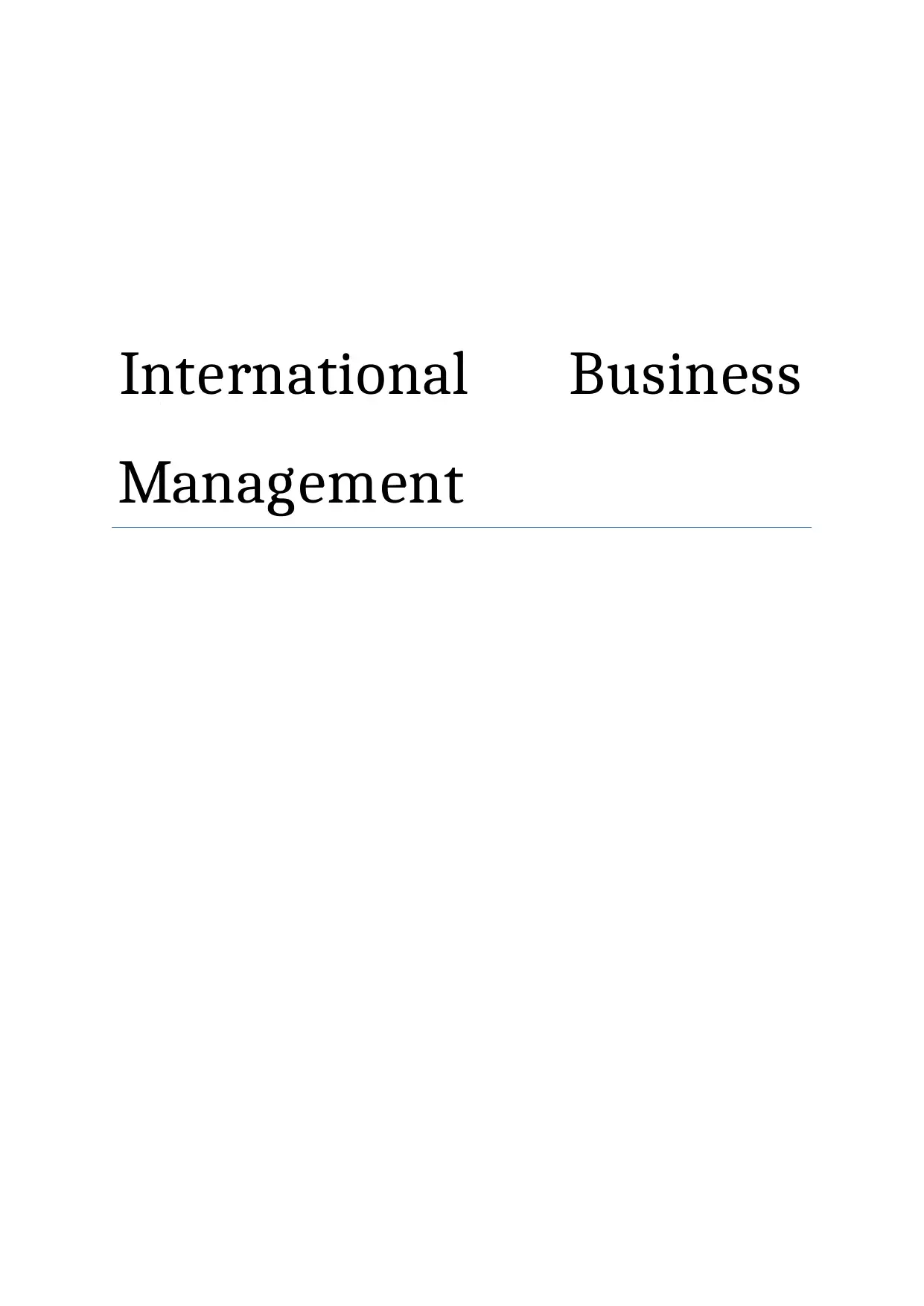
International Business
Management
Management
Secure Best Marks with AI Grader
Need help grading? Try our AI Grader for instant feedback on your assignments.
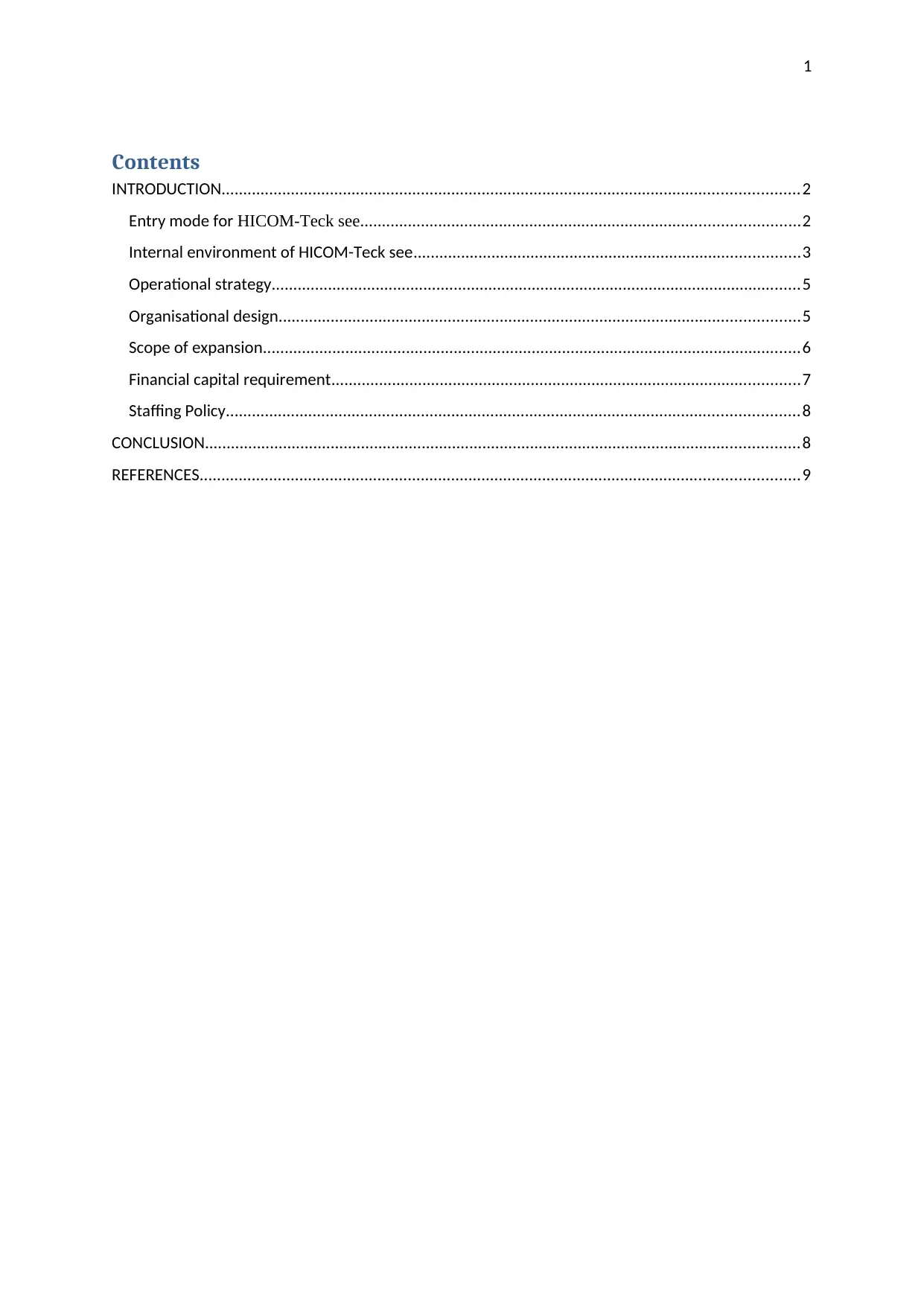
1
Contents
INTRODUCTION.....................................................................................................................................2
Entry mode for HICOM-Teck see.....................................................................................................2
Internal environment of HICOM-Teck see.........................................................................................3
Operational strategy..........................................................................................................................5
Organisational design........................................................................................................................5
Scope of expansion............................................................................................................................6
Financial capital requirement............................................................................................................7
Staffing Policy....................................................................................................................................8
CONCLUSION.........................................................................................................................................8
REFERENCES..........................................................................................................................................9
Contents
INTRODUCTION.....................................................................................................................................2
Entry mode for HICOM-Teck see.....................................................................................................2
Internal environment of HICOM-Teck see.........................................................................................3
Operational strategy..........................................................................................................................5
Organisational design........................................................................................................................5
Scope of expansion............................................................................................................................6
Financial capital requirement............................................................................................................7
Staffing Policy....................................................................................................................................8
CONCLUSION.........................................................................................................................................8
REFERENCES..........................................................................................................................................9
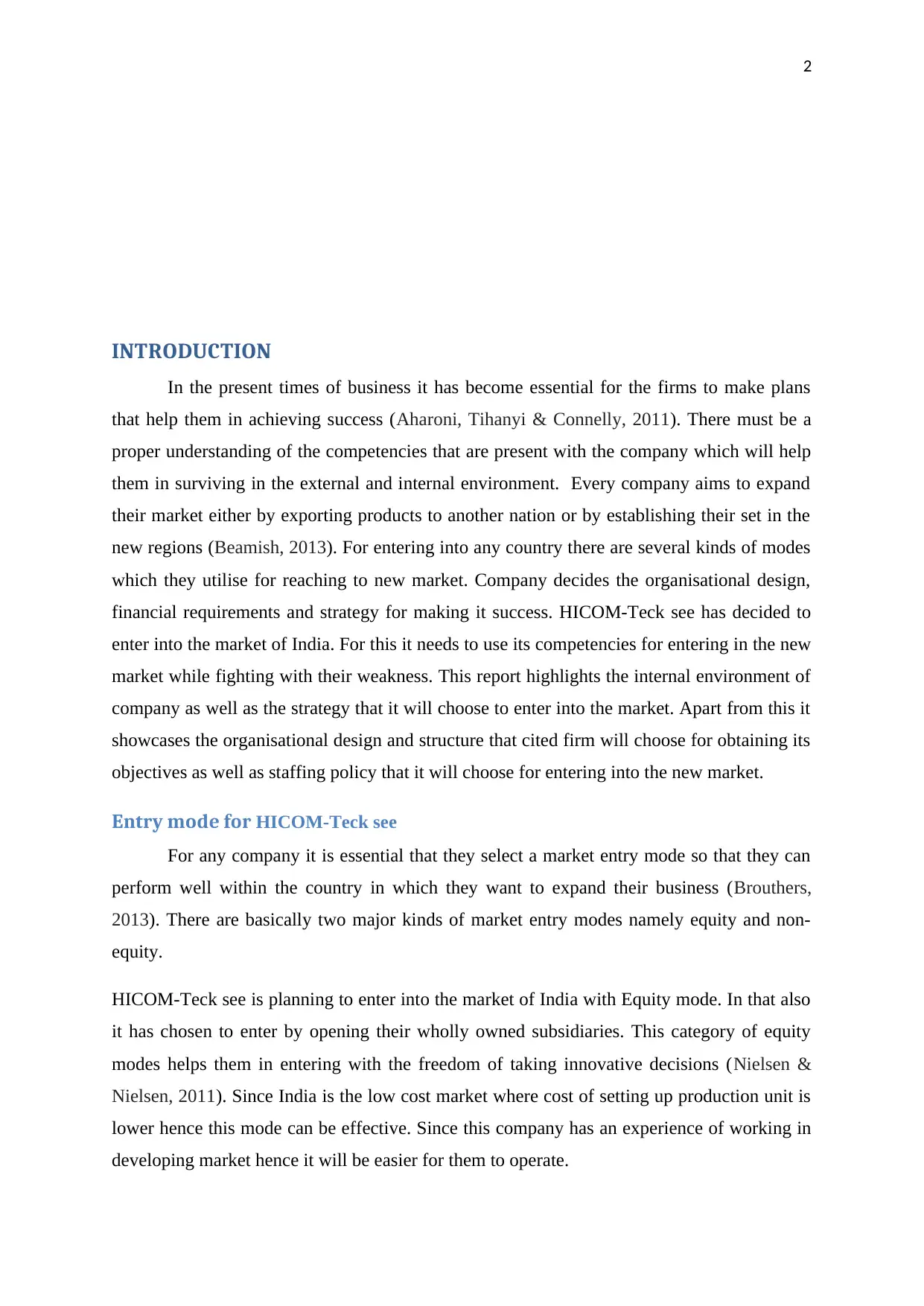
2
INTRODUCTION
In the present times of business it has become essential for the firms to make plans
that help them in achieving success (Aharoni, Tihanyi & Connelly, 2011). There must be a
proper understanding of the competencies that are present with the company which will help
them in surviving in the external and internal environment. Every company aims to expand
their market either by exporting products to another nation or by establishing their set in the
new regions (Beamish, 2013). For entering into any country there are several kinds of modes
which they utilise for reaching to new market. Company decides the organisational design,
financial requirements and strategy for making it success. HICOM-Teck see has decided to
enter into the market of India. For this it needs to use its competencies for entering in the new
market while fighting with their weakness. This report highlights the internal environment of
company as well as the strategy that it will choose to enter into the market. Apart from this it
showcases the organisational design and structure that cited firm will choose for obtaining its
objectives as well as staffing policy that it will choose for entering into the new market.
Entry mode for HICOM-Teck see
For any company it is essential that they select a market entry mode so that they can
perform well within the country in which they want to expand their business (Brouthers,
2013). There are basically two major kinds of market entry modes namely equity and non-
equity.
HICOM-Teck see is planning to enter into the market of India with Equity mode. In that also
it has chosen to enter by opening their wholly owned subsidiaries. This category of equity
modes helps them in entering with the freedom of taking innovative decisions (Nielsen &
Nielsen, 2011). Since India is the low cost market where cost of setting up production unit is
lower hence this mode can be effective. Since this company has an experience of working in
developing market hence it will be easier for them to operate.
INTRODUCTION
In the present times of business it has become essential for the firms to make plans
that help them in achieving success (Aharoni, Tihanyi & Connelly, 2011). There must be a
proper understanding of the competencies that are present with the company which will help
them in surviving in the external and internal environment. Every company aims to expand
their market either by exporting products to another nation or by establishing their set in the
new regions (Beamish, 2013). For entering into any country there are several kinds of modes
which they utilise for reaching to new market. Company decides the organisational design,
financial requirements and strategy for making it success. HICOM-Teck see has decided to
enter into the market of India. For this it needs to use its competencies for entering in the new
market while fighting with their weakness. This report highlights the internal environment of
company as well as the strategy that it will choose to enter into the market. Apart from this it
showcases the organisational design and structure that cited firm will choose for obtaining its
objectives as well as staffing policy that it will choose for entering into the new market.
Entry mode for HICOM-Teck see
For any company it is essential that they select a market entry mode so that they can
perform well within the country in which they want to expand their business (Brouthers,
2013). There are basically two major kinds of market entry modes namely equity and non-
equity.
HICOM-Teck see is planning to enter into the market of India with Equity mode. In that also
it has chosen to enter by opening their wholly owned subsidiaries. This category of equity
modes helps them in entering with the freedom of taking innovative decisions (Nielsen &
Nielsen, 2011). Since India is the low cost market where cost of setting up production unit is
lower hence this mode can be effective. Since this company has an experience of working in
developing market hence it will be easier for them to operate.
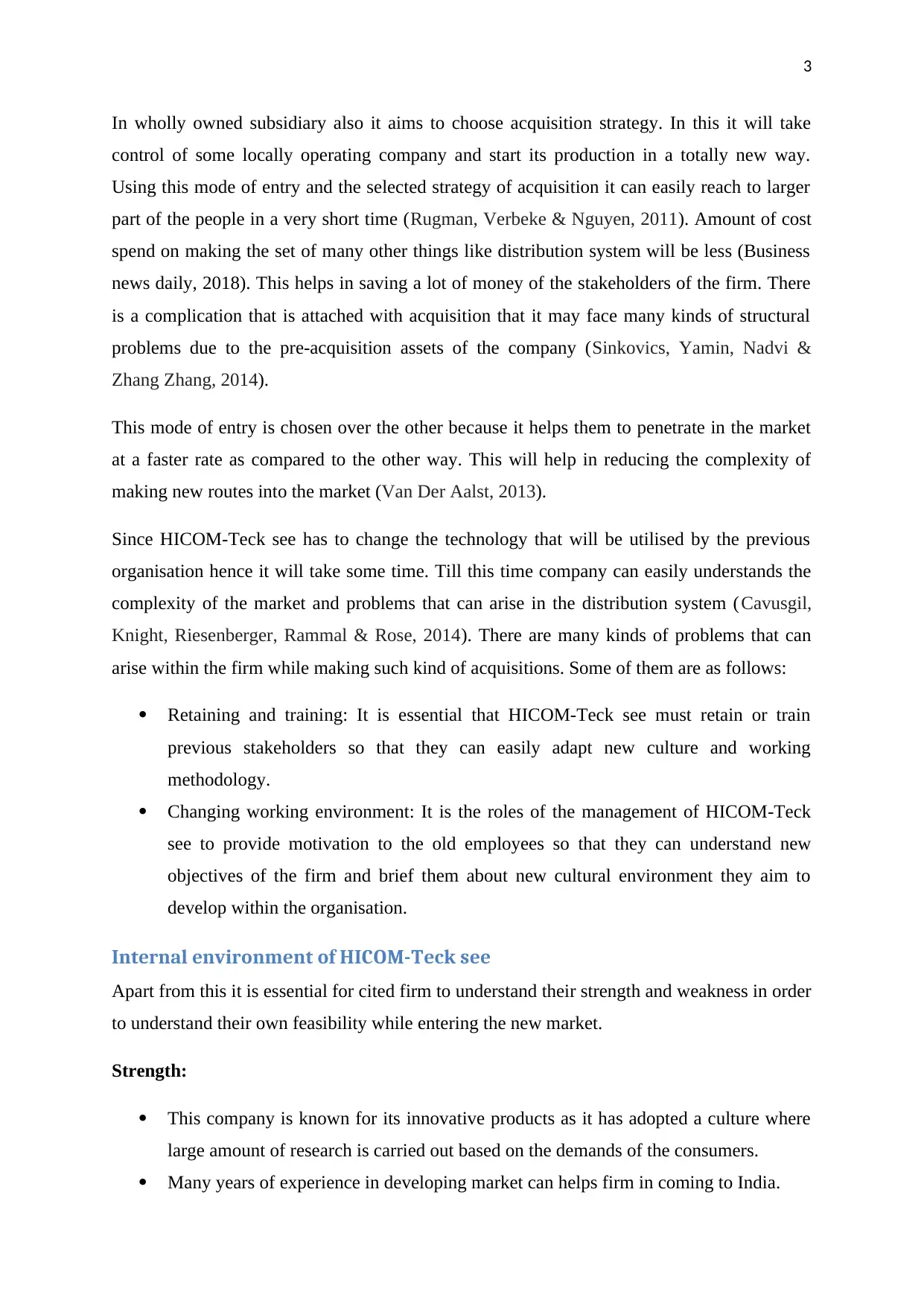
3
In wholly owned subsidiary also it aims to choose acquisition strategy. In this it will take
control of some locally operating company and start its production in a totally new way.
Using this mode of entry and the selected strategy of acquisition it can easily reach to larger
part of the people in a very short time (Rugman, Verbeke & Nguyen, 2011). Amount of cost
spend on making the set of many other things like distribution system will be less (Business
news daily, 2018). This helps in saving a lot of money of the stakeholders of the firm. There
is a complication that is attached with acquisition that it may face many kinds of structural
problems due to the pre-acquisition assets of the company (Sinkovics, Yamin, Nadvi &
Zhang Zhang, 2014).
This mode of entry is chosen over the other because it helps them to penetrate in the market
at a faster rate as compared to the other way. This will help in reducing the complexity of
making new routes into the market (Van Der Aalst, 2013).
Since HICOM-Teck see has to change the technology that will be utilised by the previous
organisation hence it will take some time. Till this time company can easily understands the
complexity of the market and problems that can arise in the distribution system (Cavusgil,
Knight, Riesenberger, Rammal & Rose, 2014). There are many kinds of problems that can
arise within the firm while making such kind of acquisitions. Some of them are as follows:
Retaining and training: It is essential that HICOM-Teck see must retain or train
previous stakeholders so that they can easily adapt new culture and working
methodology.
Changing working environment: It is the roles of the management of HICOM-Teck
see to provide motivation to the old employees so that they can understand new
objectives of the firm and brief them about new cultural environment they aim to
develop within the organisation.
Internal environment of HICOM-Teck see
Apart from this it is essential for cited firm to understand their strength and weakness in order
to understand their own feasibility while entering the new market.
Strength:
This company is known for its innovative products as it has adopted a culture where
large amount of research is carried out based on the demands of the consumers.
Many years of experience in developing market can helps firm in coming to India.
In wholly owned subsidiary also it aims to choose acquisition strategy. In this it will take
control of some locally operating company and start its production in a totally new way.
Using this mode of entry and the selected strategy of acquisition it can easily reach to larger
part of the people in a very short time (Rugman, Verbeke & Nguyen, 2011). Amount of cost
spend on making the set of many other things like distribution system will be less (Business
news daily, 2018). This helps in saving a lot of money of the stakeholders of the firm. There
is a complication that is attached with acquisition that it may face many kinds of structural
problems due to the pre-acquisition assets of the company (Sinkovics, Yamin, Nadvi &
Zhang Zhang, 2014).
This mode of entry is chosen over the other because it helps them to penetrate in the market
at a faster rate as compared to the other way. This will help in reducing the complexity of
making new routes into the market (Van Der Aalst, 2013).
Since HICOM-Teck see has to change the technology that will be utilised by the previous
organisation hence it will take some time. Till this time company can easily understands the
complexity of the market and problems that can arise in the distribution system (Cavusgil,
Knight, Riesenberger, Rammal & Rose, 2014). There are many kinds of problems that can
arise within the firm while making such kind of acquisitions. Some of them are as follows:
Retaining and training: It is essential that HICOM-Teck see must retain or train
previous stakeholders so that they can easily adapt new culture and working
methodology.
Changing working environment: It is the roles of the management of HICOM-Teck
see to provide motivation to the old employees so that they can understand new
objectives of the firm and brief them about new cultural environment they aim to
develop within the organisation.
Internal environment of HICOM-Teck see
Apart from this it is essential for cited firm to understand their strength and weakness in order
to understand their own feasibility while entering the new market.
Strength:
This company is known for its innovative products as it has adopted a culture where
large amount of research is carried out based on the demands of the consumers.
Many years of experience in developing market can helps firm in coming to India.
Secure Best Marks with AI Grader
Need help grading? Try our AI Grader for instant feedback on your assignments.
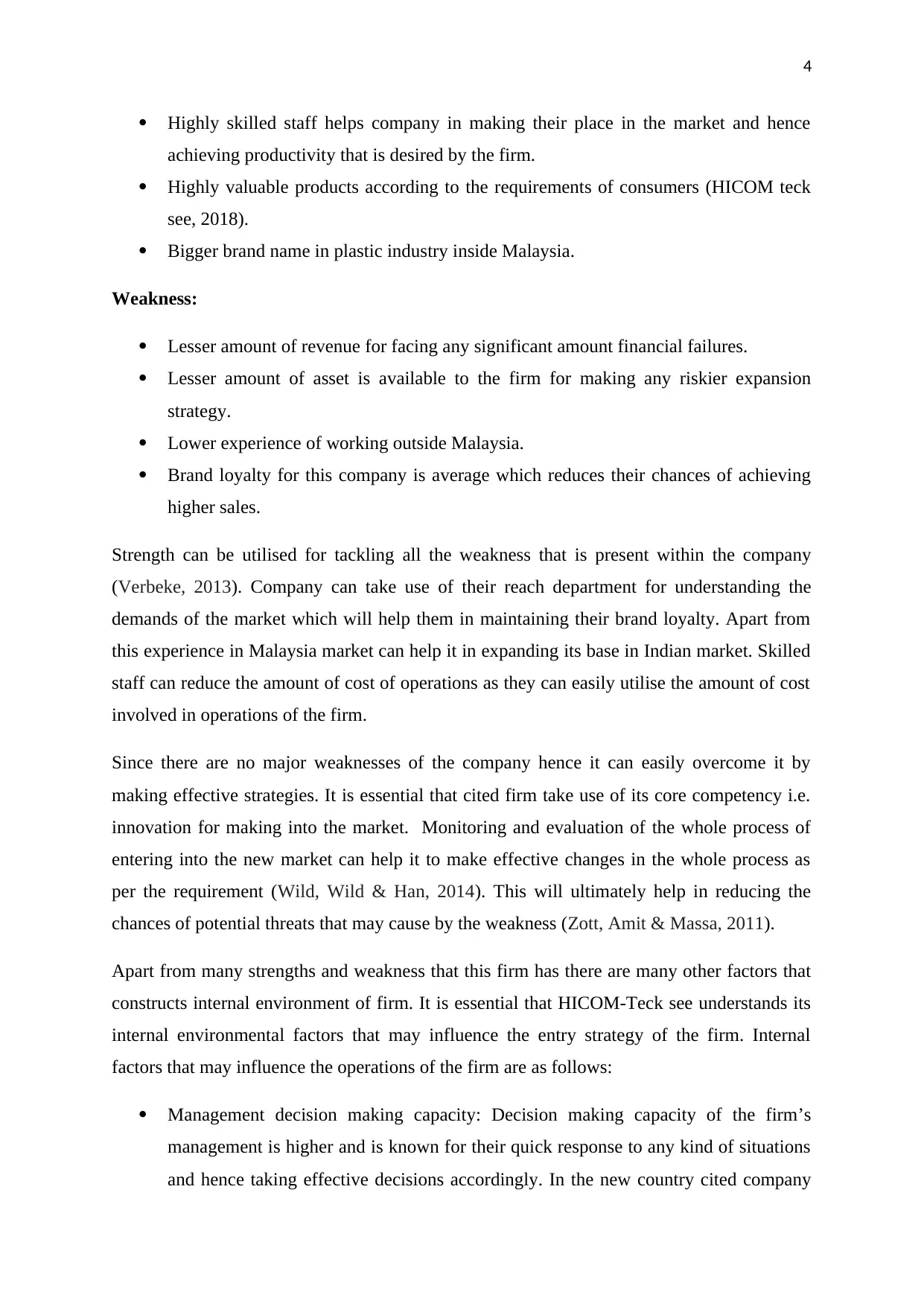
4
Highly skilled staff helps company in making their place in the market and hence
achieving productivity that is desired by the firm.
Highly valuable products according to the requirements of consumers (HICOM teck
see, 2018).
Bigger brand name in plastic industry inside Malaysia.
Weakness:
Lesser amount of revenue for facing any significant amount financial failures.
Lesser amount of asset is available to the firm for making any riskier expansion
strategy.
Lower experience of working outside Malaysia.
Brand loyalty for this company is average which reduces their chances of achieving
higher sales.
Strength can be utilised for tackling all the weakness that is present within the company
(Verbeke, 2013). Company can take use of their reach department for understanding the
demands of the market which will help them in maintaining their brand loyalty. Apart from
this experience in Malaysia market can help it in expanding its base in Indian market. Skilled
staff can reduce the amount of cost of operations as they can easily utilise the amount of cost
involved in operations of the firm.
Since there are no major weaknesses of the company hence it can easily overcome it by
making effective strategies. It is essential that cited firm take use of its core competency i.e.
innovation for making into the market. Monitoring and evaluation of the whole process of
entering into the new market can help it to make effective changes in the whole process as
per the requirement (Wild, Wild & Han, 2014). This will ultimately help in reducing the
chances of potential threats that may cause by the weakness (Zott, Amit & Massa, 2011).
Apart from many strengths and weakness that this firm has there are many other factors that
constructs internal environment of firm. It is essential that HICOM-Teck see understands its
internal environmental factors that may influence the entry strategy of the firm. Internal
factors that may influence the operations of the firm are as follows:
Management decision making capacity: Decision making capacity of the firm’s
management is higher and is known for their quick response to any kind of situations
and hence taking effective decisions accordingly. In the new country cited company
Highly skilled staff helps company in making their place in the market and hence
achieving productivity that is desired by the firm.
Highly valuable products according to the requirements of consumers (HICOM teck
see, 2018).
Bigger brand name in plastic industry inside Malaysia.
Weakness:
Lesser amount of revenue for facing any significant amount financial failures.
Lesser amount of asset is available to the firm for making any riskier expansion
strategy.
Lower experience of working outside Malaysia.
Brand loyalty for this company is average which reduces their chances of achieving
higher sales.
Strength can be utilised for tackling all the weakness that is present within the company
(Verbeke, 2013). Company can take use of their reach department for understanding the
demands of the market which will help them in maintaining their brand loyalty. Apart from
this experience in Malaysia market can help it in expanding its base in Indian market. Skilled
staff can reduce the amount of cost of operations as they can easily utilise the amount of cost
involved in operations of the firm.
Since there are no major weaknesses of the company hence it can easily overcome it by
making effective strategies. It is essential that cited firm take use of its core competency i.e.
innovation for making into the market. Monitoring and evaluation of the whole process of
entering into the new market can help it to make effective changes in the whole process as
per the requirement (Wild, Wild & Han, 2014). This will ultimately help in reducing the
chances of potential threats that may cause by the weakness (Zott, Amit & Massa, 2011).
Apart from many strengths and weakness that this firm has there are many other factors that
constructs internal environment of firm. It is essential that HICOM-Teck see understands its
internal environmental factors that may influence the entry strategy of the firm. Internal
factors that may influence the operations of the firm are as follows:
Management decision making capacity: Decision making capacity of the firm’s
management is higher and is known for their quick response to any kind of situations
and hence taking effective decisions accordingly. In the new country cited company
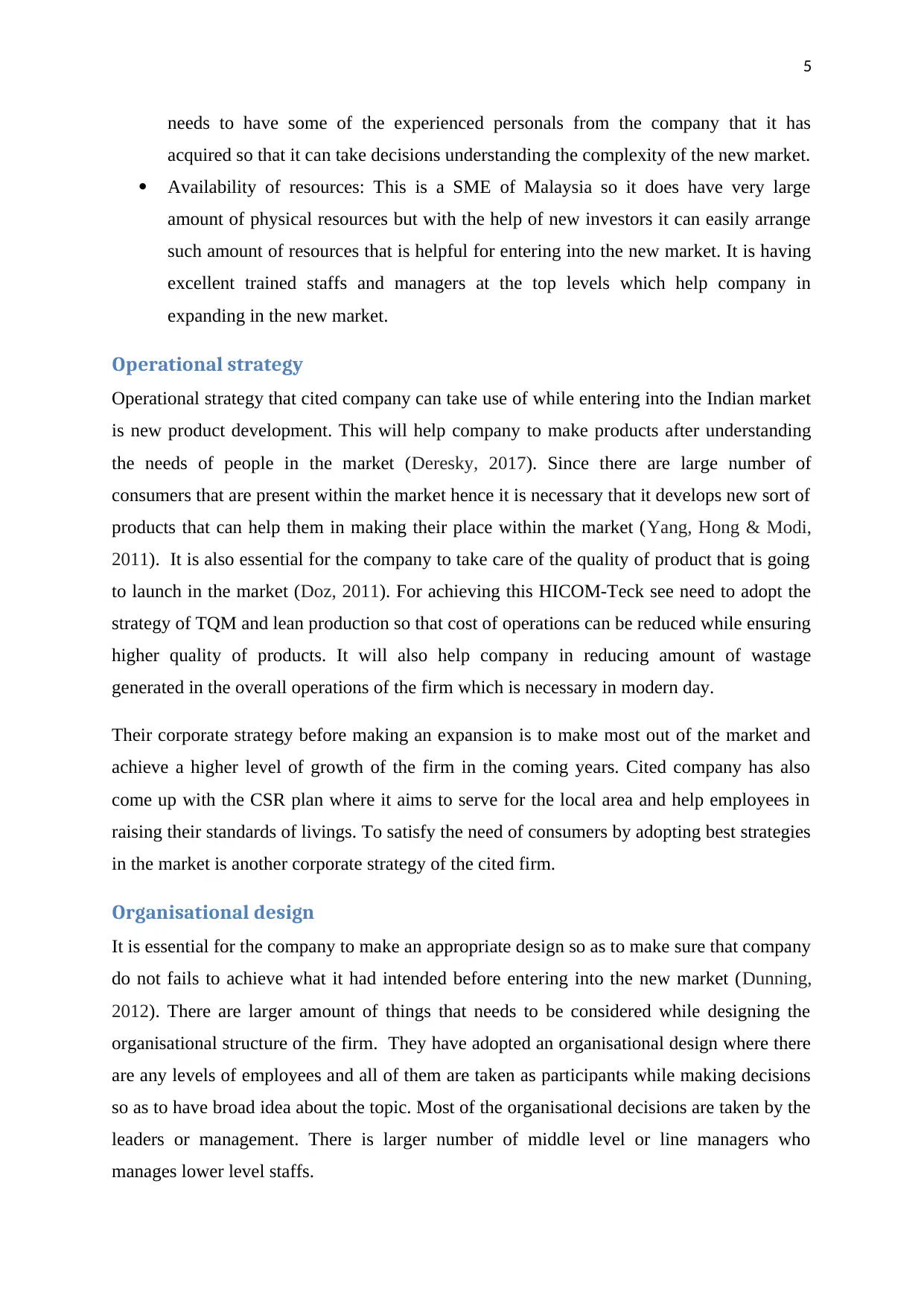
5
needs to have some of the experienced personals from the company that it has
acquired so that it can take decisions understanding the complexity of the new market.
Availability of resources: This is a SME of Malaysia so it does have very large
amount of physical resources but with the help of new investors it can easily arrange
such amount of resources that is helpful for entering into the new market. It is having
excellent trained staffs and managers at the top levels which help company in
expanding in the new market.
Operational strategy
Operational strategy that cited company can take use of while entering into the Indian market
is new product development. This will help company to make products after understanding
the needs of people in the market (Deresky, 2017). Since there are large number of
consumers that are present within the market hence it is necessary that it develops new sort of
products that can help them in making their place within the market (Yang, Hong & Modi,
2011). It is also essential for the company to take care of the quality of product that is going
to launch in the market (Doz, 2011). For achieving this HICOM-Teck see need to adopt the
strategy of TQM and lean production so that cost of operations can be reduced while ensuring
higher quality of products. It will also help company in reducing amount of wastage
generated in the overall operations of the firm which is necessary in modern day.
Their corporate strategy before making an expansion is to make most out of the market and
achieve a higher level of growth of the firm in the coming years. Cited company has also
come up with the CSR plan where it aims to serve for the local area and help employees in
raising their standards of livings. To satisfy the need of consumers by adopting best strategies
in the market is another corporate strategy of the cited firm.
Organisational design
It is essential for the company to make an appropriate design so as to make sure that company
do not fails to achieve what it had intended before entering into the new market (Dunning,
2012). There are larger amount of things that needs to be considered while designing the
organisational structure of the firm. They have adopted an organisational design where there
are any levels of employees and all of them are taken as participants while making decisions
so as to have broad idea about the topic. Most of the organisational decisions are taken by the
leaders or management. There is larger number of middle level or line managers who
manages lower level staffs.
needs to have some of the experienced personals from the company that it has
acquired so that it can take decisions understanding the complexity of the new market.
Availability of resources: This is a SME of Malaysia so it does have very large
amount of physical resources but with the help of new investors it can easily arrange
such amount of resources that is helpful for entering into the new market. It is having
excellent trained staffs and managers at the top levels which help company in
expanding in the new market.
Operational strategy
Operational strategy that cited company can take use of while entering into the Indian market
is new product development. This will help company to make products after understanding
the needs of people in the market (Deresky, 2017). Since there are large number of
consumers that are present within the market hence it is necessary that it develops new sort of
products that can help them in making their place within the market (Yang, Hong & Modi,
2011). It is also essential for the company to take care of the quality of product that is going
to launch in the market (Doz, 2011). For achieving this HICOM-Teck see need to adopt the
strategy of TQM and lean production so that cost of operations can be reduced while ensuring
higher quality of products. It will also help company in reducing amount of wastage
generated in the overall operations of the firm which is necessary in modern day.
Their corporate strategy before making an expansion is to make most out of the market and
achieve a higher level of growth of the firm in the coming years. Cited company has also
come up with the CSR plan where it aims to serve for the local area and help employees in
raising their standards of livings. To satisfy the need of consumers by adopting best strategies
in the market is another corporate strategy of the cited firm.
Organisational design
It is essential for the company to make an appropriate design so as to make sure that company
do not fails to achieve what it had intended before entering into the new market (Dunning,
2012). There are larger amount of things that needs to be considered while designing the
organisational structure of the firm. They have adopted an organisational design where there
are any levels of employees and all of them are taken as participants while making decisions
so as to have broad idea about the topic. Most of the organisational decisions are taken by the
leaders or management. There is larger number of middle level or line managers who
manages lower level staffs.
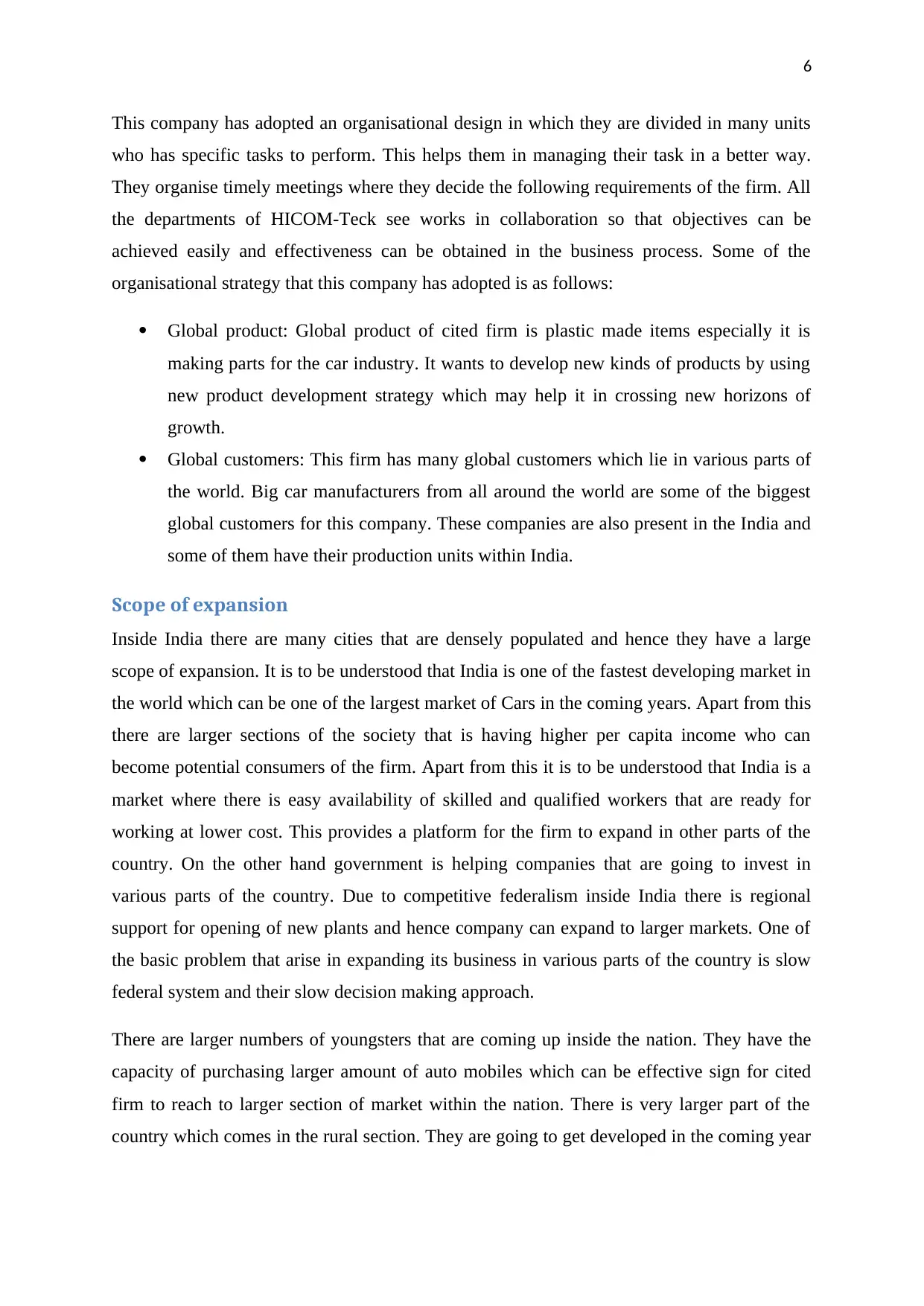
6
This company has adopted an organisational design in which they are divided in many units
who has specific tasks to perform. This helps them in managing their task in a better way.
They organise timely meetings where they decide the following requirements of the firm. All
the departments of HICOM-Teck see works in collaboration so that objectives can be
achieved easily and effectiveness can be obtained in the business process. Some of the
organisational strategy that this company has adopted is as follows:
Global product: Global product of cited firm is plastic made items especially it is
making parts for the car industry. It wants to develop new kinds of products by using
new product development strategy which may help it in crossing new horizons of
growth.
Global customers: This firm has many global customers which lie in various parts of
the world. Big car manufacturers from all around the world are some of the biggest
global customers for this company. These companies are also present in the India and
some of them have their production units within India.
Scope of expansion
Inside India there are many cities that are densely populated and hence they have a large
scope of expansion. It is to be understood that India is one of the fastest developing market in
the world which can be one of the largest market of Cars in the coming years. Apart from this
there are larger sections of the society that is having higher per capita income who can
become potential consumers of the firm. Apart from this it is to be understood that India is a
market where there is easy availability of skilled and qualified workers that are ready for
working at lower cost. This provides a platform for the firm to expand in other parts of the
country. On the other hand government is helping companies that are going to invest in
various parts of the country. Due to competitive federalism inside India there is regional
support for opening of new plants and hence company can expand to larger markets. One of
the basic problem that arise in expanding its business in various parts of the country is slow
federal system and their slow decision making approach.
There are larger numbers of youngsters that are coming up inside the nation. They have the
capacity of purchasing larger amount of auto mobiles which can be effective sign for cited
firm to reach to larger section of market within the nation. There is very larger part of the
country which comes in the rural section. They are going to get developed in the coming year
This company has adopted an organisational design in which they are divided in many units
who has specific tasks to perform. This helps them in managing their task in a better way.
They organise timely meetings where they decide the following requirements of the firm. All
the departments of HICOM-Teck see works in collaboration so that objectives can be
achieved easily and effectiveness can be obtained in the business process. Some of the
organisational strategy that this company has adopted is as follows:
Global product: Global product of cited firm is plastic made items especially it is
making parts for the car industry. It wants to develop new kinds of products by using
new product development strategy which may help it in crossing new horizons of
growth.
Global customers: This firm has many global customers which lie in various parts of
the world. Big car manufacturers from all around the world are some of the biggest
global customers for this company. These companies are also present in the India and
some of them have their production units within India.
Scope of expansion
Inside India there are many cities that are densely populated and hence they have a large
scope of expansion. It is to be understood that India is one of the fastest developing market in
the world which can be one of the largest market of Cars in the coming years. Apart from this
there are larger sections of the society that is having higher per capita income who can
become potential consumers of the firm. Apart from this it is to be understood that India is a
market where there is easy availability of skilled and qualified workers that are ready for
working at lower cost. This provides a platform for the firm to expand in other parts of the
country. On the other hand government is helping companies that are going to invest in
various parts of the country. Due to competitive federalism inside India there is regional
support for opening of new plants and hence company can expand to larger markets. One of
the basic problem that arise in expanding its business in various parts of the country is slow
federal system and their slow decision making approach.
There are larger numbers of youngsters that are coming up inside the nation. They have the
capacity of purchasing larger amount of auto mobiles which can be effective sign for cited
firm to reach to larger section of market within the nation. There is very larger part of the
country which comes in the rural section. They are going to get developed in the coming year
Paraphrase This Document
Need a fresh take? Get an instant paraphrase of this document with our AI Paraphraser
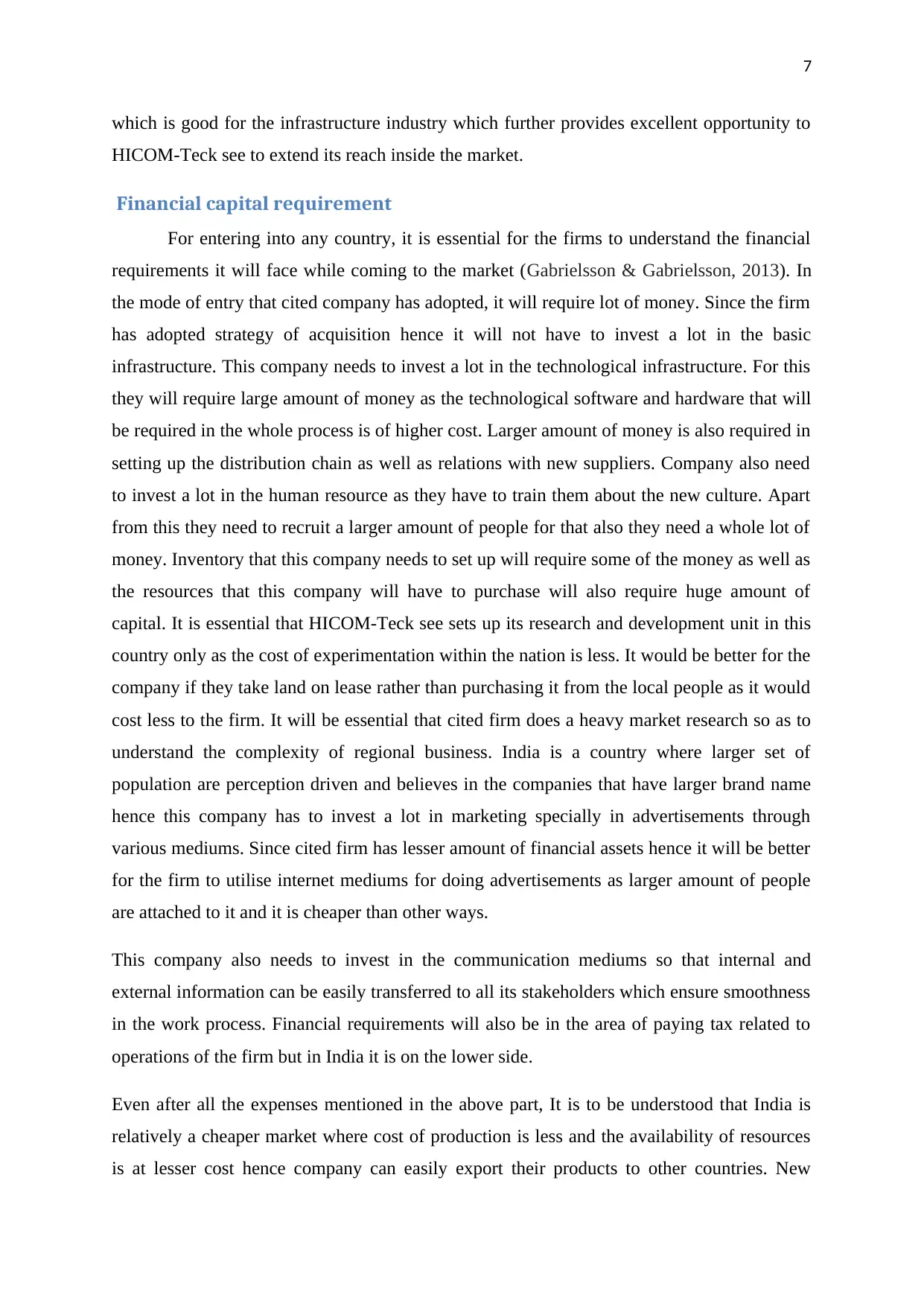
7
which is good for the infrastructure industry which further provides excellent opportunity to
HICOM-Teck see to extend its reach inside the market.
Financial capital requirement
For entering into any country, it is essential for the firms to understand the financial
requirements it will face while coming to the market (Gabrielsson & Gabrielsson, 2013). In
the mode of entry that cited company has adopted, it will require lot of money. Since the firm
has adopted strategy of acquisition hence it will not have to invest a lot in the basic
infrastructure. This company needs to invest a lot in the technological infrastructure. For this
they will require large amount of money as the technological software and hardware that will
be required in the whole process is of higher cost. Larger amount of money is also required in
setting up the distribution chain as well as relations with new suppliers. Company also need
to invest a lot in the human resource as they have to train them about the new culture. Apart
from this they need to recruit a larger amount of people for that also they need a whole lot of
money. Inventory that this company needs to set up will require some of the money as well as
the resources that this company will have to purchase will also require huge amount of
capital. It is essential that HICOM-Teck see sets up its research and development unit in this
country only as the cost of experimentation within the nation is less. It would be better for the
company if they take land on lease rather than purchasing it from the local people as it would
cost less to the firm. It will be essential that cited firm does a heavy market research so as to
understand the complexity of regional business. India is a country where larger set of
population are perception driven and believes in the companies that have larger brand name
hence this company has to invest a lot in marketing specially in advertisements through
various mediums. Since cited firm has lesser amount of financial assets hence it will be better
for the firm to utilise internet mediums for doing advertisements as larger amount of people
are attached to it and it is cheaper than other ways.
This company also needs to invest in the communication mediums so that internal and
external information can be easily transferred to all its stakeholders which ensure smoothness
in the work process. Financial requirements will also be in the area of paying tax related to
operations of the firm but in India it is on the lower side.
Even after all the expenses mentioned in the above part, It is to be understood that India is
relatively a cheaper market where cost of production is less and the availability of resources
is at lesser cost hence company can easily export their products to other countries. New
which is good for the infrastructure industry which further provides excellent opportunity to
HICOM-Teck see to extend its reach inside the market.
Financial capital requirement
For entering into any country, it is essential for the firms to understand the financial
requirements it will face while coming to the market (Gabrielsson & Gabrielsson, 2013). In
the mode of entry that cited company has adopted, it will require lot of money. Since the firm
has adopted strategy of acquisition hence it will not have to invest a lot in the basic
infrastructure. This company needs to invest a lot in the technological infrastructure. For this
they will require large amount of money as the technological software and hardware that will
be required in the whole process is of higher cost. Larger amount of money is also required in
setting up the distribution chain as well as relations with new suppliers. Company also need
to invest a lot in the human resource as they have to train them about the new culture. Apart
from this they need to recruit a larger amount of people for that also they need a whole lot of
money. Inventory that this company needs to set up will require some of the money as well as
the resources that this company will have to purchase will also require huge amount of
capital. It is essential that HICOM-Teck see sets up its research and development unit in this
country only as the cost of experimentation within the nation is less. It would be better for the
company if they take land on lease rather than purchasing it from the local people as it would
cost less to the firm. It will be essential that cited firm does a heavy market research so as to
understand the complexity of regional business. India is a country where larger set of
population are perception driven and believes in the companies that have larger brand name
hence this company has to invest a lot in marketing specially in advertisements through
various mediums. Since cited firm has lesser amount of financial assets hence it will be better
for the firm to utilise internet mediums for doing advertisements as larger amount of people
are attached to it and it is cheaper than other ways.
This company also needs to invest in the communication mediums so that internal and
external information can be easily transferred to all its stakeholders which ensure smoothness
in the work process. Financial requirements will also be in the area of paying tax related to
operations of the firm but in India it is on the lower side.
Even after all the expenses mentioned in the above part, It is to be understood that India is
relatively a cheaper market where cost of production is less and the availability of resources
is at lesser cost hence company can easily export their products to other countries. New
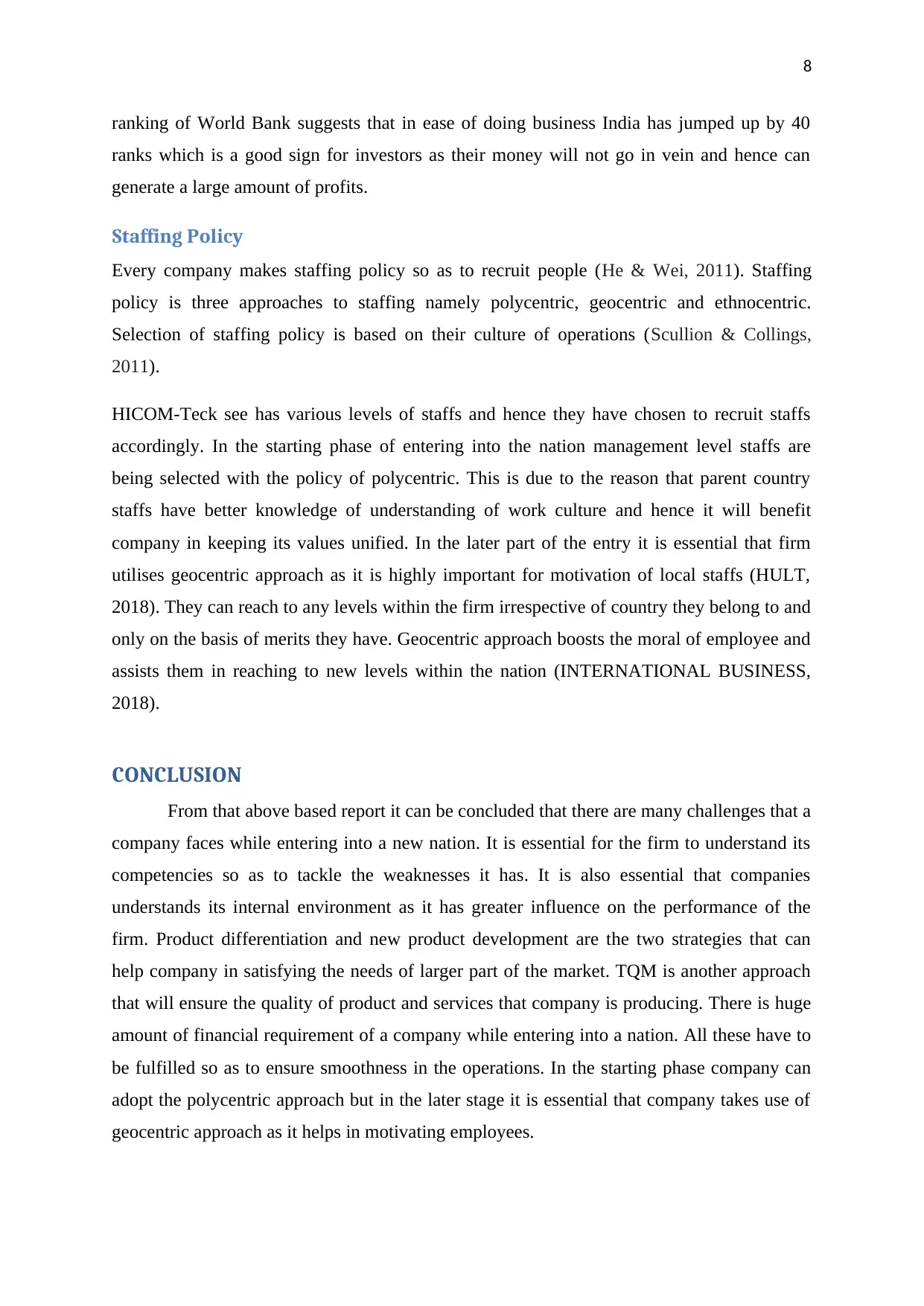
8
ranking of World Bank suggests that in ease of doing business India has jumped up by 40
ranks which is a good sign for investors as their money will not go in vein and hence can
generate a large amount of profits.
Staffing Policy
Every company makes staffing policy so as to recruit people (He & Wei, 2011). Staffing
policy is three approaches to staffing namely polycentric, geocentric and ethnocentric.
Selection of staffing policy is based on their culture of operations (Scullion & Collings,
2011).
HICOM-Teck see has various levels of staffs and hence they have chosen to recruit staffs
accordingly. In the starting phase of entering into the nation management level staffs are
being selected with the policy of polycentric. This is due to the reason that parent country
staffs have better knowledge of understanding of work culture and hence it will benefit
company in keeping its values unified. In the later part of the entry it is essential that firm
utilises geocentric approach as it is highly important for motivation of local staffs (HULT,
2018). They can reach to any levels within the firm irrespective of country they belong to and
only on the basis of merits they have. Geocentric approach boosts the moral of employee and
assists them in reaching to new levels within the nation (INTERNATIONAL BUSINESS,
2018).
CONCLUSION
From that above based report it can be concluded that there are many challenges that a
company faces while entering into a new nation. It is essential for the firm to understand its
competencies so as to tackle the weaknesses it has. It is also essential that companies
understands its internal environment as it has greater influence on the performance of the
firm. Product differentiation and new product development are the two strategies that can
help company in satisfying the needs of larger part of the market. TQM is another approach
that will ensure the quality of product and services that company is producing. There is huge
amount of financial requirement of a company while entering into a nation. All these have to
be fulfilled so as to ensure smoothness in the operations. In the starting phase company can
adopt the polycentric approach but in the later stage it is essential that company takes use of
geocentric approach as it helps in motivating employees.
ranking of World Bank suggests that in ease of doing business India has jumped up by 40
ranks which is a good sign for investors as their money will not go in vein and hence can
generate a large amount of profits.
Staffing Policy
Every company makes staffing policy so as to recruit people (He & Wei, 2011). Staffing
policy is three approaches to staffing namely polycentric, geocentric and ethnocentric.
Selection of staffing policy is based on their culture of operations (Scullion & Collings,
2011).
HICOM-Teck see has various levels of staffs and hence they have chosen to recruit staffs
accordingly. In the starting phase of entering into the nation management level staffs are
being selected with the policy of polycentric. This is due to the reason that parent country
staffs have better knowledge of understanding of work culture and hence it will benefit
company in keeping its values unified. In the later part of the entry it is essential that firm
utilises geocentric approach as it is highly important for motivation of local staffs (HULT,
2018). They can reach to any levels within the firm irrespective of country they belong to and
only on the basis of merits they have. Geocentric approach boosts the moral of employee and
assists them in reaching to new levels within the nation (INTERNATIONAL BUSINESS,
2018).
CONCLUSION
From that above based report it can be concluded that there are many challenges that a
company faces while entering into a new nation. It is essential for the firm to understand its
competencies so as to tackle the weaknesses it has. It is also essential that companies
understands its internal environment as it has greater influence on the performance of the
firm. Product differentiation and new product development are the two strategies that can
help company in satisfying the needs of larger part of the market. TQM is another approach
that will ensure the quality of product and services that company is producing. There is huge
amount of financial requirement of a company while entering into a nation. All these have to
be fulfilled so as to ensure smoothness in the operations. In the starting phase company can
adopt the polycentric approach but in the later stage it is essential that company takes use of
geocentric approach as it helps in motivating employees.

9
REFERENCES
Aharoni, Y., Tihanyi, L., & Connelly, B. L. (2011). Managerial decision-making in
international business: A forty-five-year retrospective. Journal of World
Business, 46(2), 135-142.
Beamish, P. (2013). Multinational joint ventures in developing countries (RLE International
Business). Routledge.
Brouthers, K. D. (2013). A retrospective on: Institutional, cultural and transaction cost
influences on entry mode choice and performance. Journal of International Business
Studies, 44(1), 14-22.
REFERENCES
Aharoni, Y., Tihanyi, L., & Connelly, B. L. (2011). Managerial decision-making in
international business: A forty-five-year retrospective. Journal of World
Business, 46(2), 135-142.
Beamish, P. (2013). Multinational joint ventures in developing countries (RLE International
Business). Routledge.
Brouthers, K. D. (2013). A retrospective on: Institutional, cultural and transaction cost
influences on entry mode choice and performance. Journal of International Business
Studies, 44(1), 14-22.
Secure Best Marks with AI Grader
Need help grading? Try our AI Grader for instant feedback on your assignments.
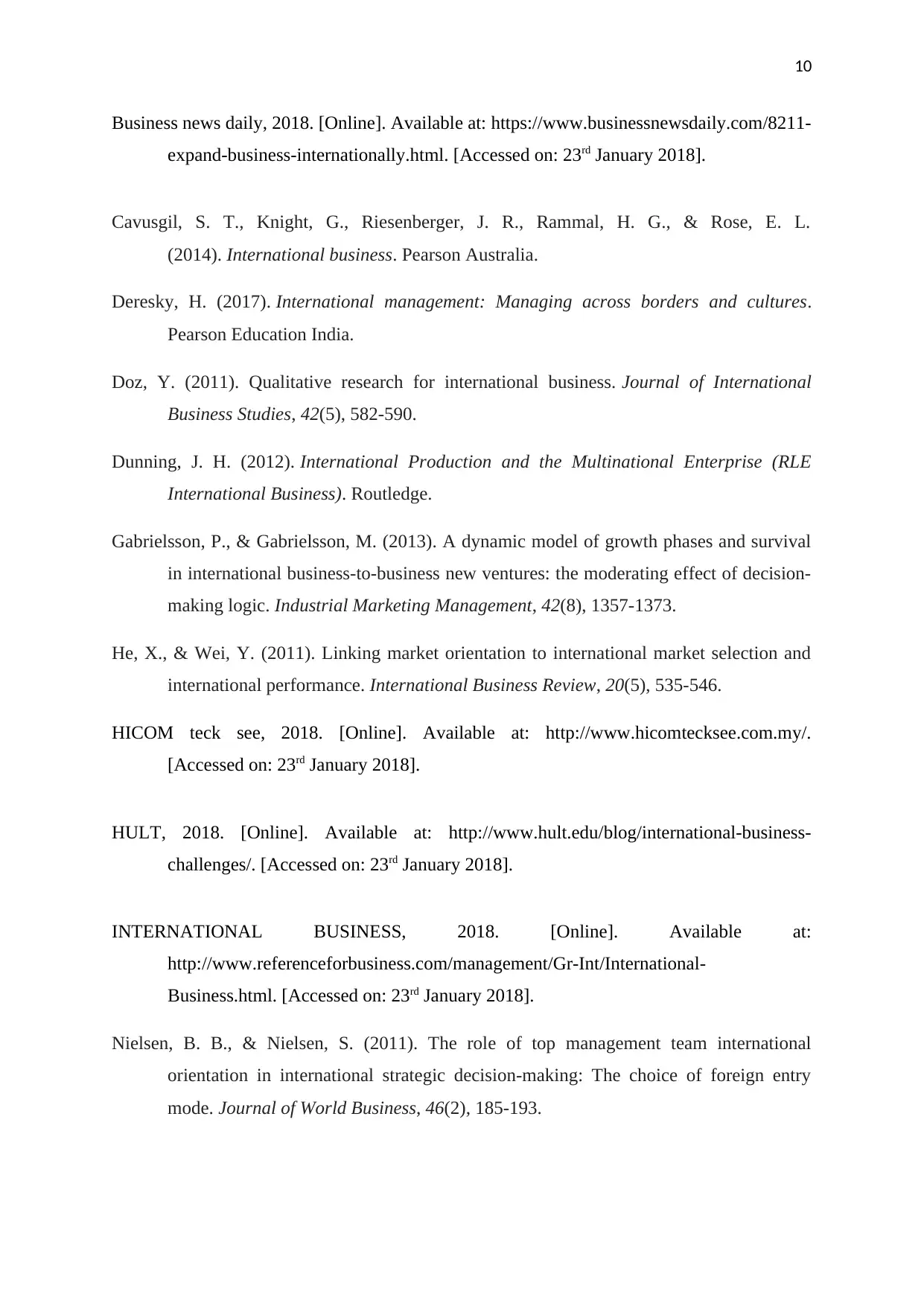
10
Business news daily, 2018. [Online]. Available at: https://www.businessnewsdaily.com/8211-
expand-business-internationally.html. [Accessed on: 23rd January 2018].
Cavusgil, S. T., Knight, G., Riesenberger, J. R., Rammal, H. G., & Rose, E. L.
(2014). International business. Pearson Australia.
Deresky, H. (2017). International management: Managing across borders and cultures.
Pearson Education India.
Doz, Y. (2011). Qualitative research for international business. Journal of International
Business Studies, 42(5), 582-590.
Dunning, J. H. (2012). International Production and the Multinational Enterprise (RLE
International Business). Routledge.
Gabrielsson, P., & Gabrielsson, M. (2013). A dynamic model of growth phases and survival
in international business-to-business new ventures: the moderating effect of decision-
making logic. Industrial Marketing Management, 42(8), 1357-1373.
He, X., & Wei, Y. (2011). Linking market orientation to international market selection and
international performance. International Business Review, 20(5), 535-546.
HICOM teck see, 2018. [Online]. Available at: http://www.hicomtecksee.com.my/.
[Accessed on: 23rd January 2018].
HULT, 2018. [Online]. Available at: http://www.hult.edu/blog/international-business-
challenges/. [Accessed on: 23rd January 2018].
INTERNATIONAL BUSINESS, 2018. [Online]. Available at:
http://www.referenceforbusiness.com/management/Gr-Int/International-
Business.html. [Accessed on: 23rd January 2018].
Nielsen, B. B., & Nielsen, S. (2011). The role of top management team international
orientation in international strategic decision-making: The choice of foreign entry
mode. Journal of World Business, 46(2), 185-193.
Business news daily, 2018. [Online]. Available at: https://www.businessnewsdaily.com/8211-
expand-business-internationally.html. [Accessed on: 23rd January 2018].
Cavusgil, S. T., Knight, G., Riesenberger, J. R., Rammal, H. G., & Rose, E. L.
(2014). International business. Pearson Australia.
Deresky, H. (2017). International management: Managing across borders and cultures.
Pearson Education India.
Doz, Y. (2011). Qualitative research for international business. Journal of International
Business Studies, 42(5), 582-590.
Dunning, J. H. (2012). International Production and the Multinational Enterprise (RLE
International Business). Routledge.
Gabrielsson, P., & Gabrielsson, M. (2013). A dynamic model of growth phases and survival
in international business-to-business new ventures: the moderating effect of decision-
making logic. Industrial Marketing Management, 42(8), 1357-1373.
He, X., & Wei, Y. (2011). Linking market orientation to international market selection and
international performance. International Business Review, 20(5), 535-546.
HICOM teck see, 2018. [Online]. Available at: http://www.hicomtecksee.com.my/.
[Accessed on: 23rd January 2018].
HULT, 2018. [Online]. Available at: http://www.hult.edu/blog/international-business-
challenges/. [Accessed on: 23rd January 2018].
INTERNATIONAL BUSINESS, 2018. [Online]. Available at:
http://www.referenceforbusiness.com/management/Gr-Int/International-
Business.html. [Accessed on: 23rd January 2018].
Nielsen, B. B., & Nielsen, S. (2011). The role of top management team international
orientation in international strategic decision-making: The choice of foreign entry
mode. Journal of World Business, 46(2), 185-193.
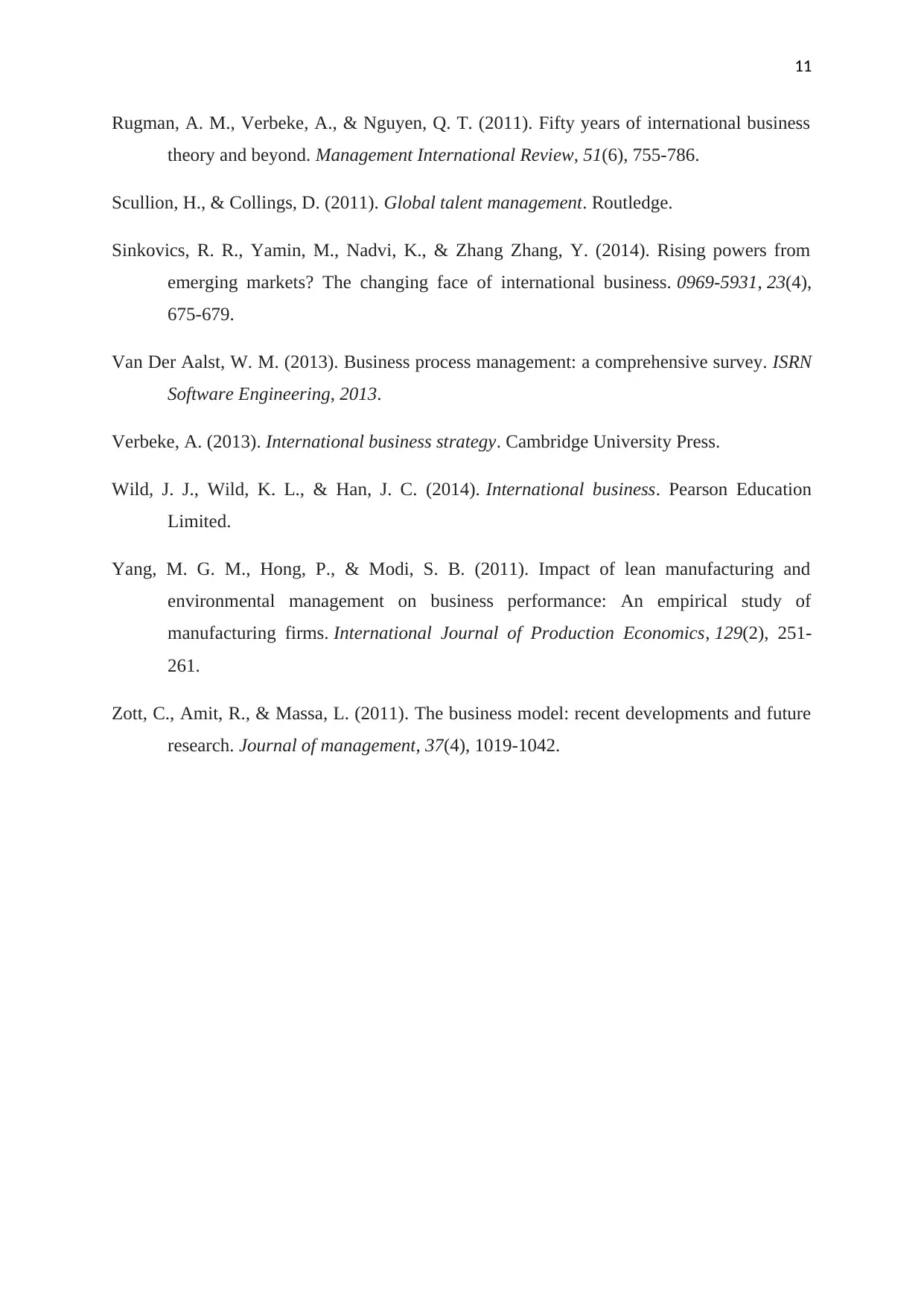
11
Rugman, A. M., Verbeke, A., & Nguyen, Q. T. (2011). Fifty years of international business
theory and beyond. Management International Review, 51(6), 755-786.
Scullion, H., & Collings, D. (2011). Global talent management. Routledge.
Sinkovics, R. R., Yamin, M., Nadvi, K., & Zhang Zhang, Y. (2014). Rising powers from
emerging markets? The changing face of international business. 0969-5931, 23(4),
675-679.
Van Der Aalst, W. M. (2013). Business process management: a comprehensive survey. ISRN
Software Engineering, 2013.
Verbeke, A. (2013). International business strategy. Cambridge University Press.
Wild, J. J., Wild, K. L., & Han, J. C. (2014). International business. Pearson Education
Limited.
Yang, M. G. M., Hong, P., & Modi, S. B. (2011). Impact of lean manufacturing and
environmental management on business performance: An empirical study of
manufacturing firms. International Journal of Production Economics, 129(2), 251-
261.
Zott, C., Amit, R., & Massa, L. (2011). The business model: recent developments and future
research. Journal of management, 37(4), 1019-1042.
Rugman, A. M., Verbeke, A., & Nguyen, Q. T. (2011). Fifty years of international business
theory and beyond. Management International Review, 51(6), 755-786.
Scullion, H., & Collings, D. (2011). Global talent management. Routledge.
Sinkovics, R. R., Yamin, M., Nadvi, K., & Zhang Zhang, Y. (2014). Rising powers from
emerging markets? The changing face of international business. 0969-5931, 23(4),
675-679.
Van Der Aalst, W. M. (2013). Business process management: a comprehensive survey. ISRN
Software Engineering, 2013.
Verbeke, A. (2013). International business strategy. Cambridge University Press.
Wild, J. J., Wild, K. L., & Han, J. C. (2014). International business. Pearson Education
Limited.
Yang, M. G. M., Hong, P., & Modi, S. B. (2011). Impact of lean manufacturing and
environmental management on business performance: An empirical study of
manufacturing firms. International Journal of Production Economics, 129(2), 251-
261.
Zott, C., Amit, R., & Massa, L. (2011). The business model: recent developments and future
research. Journal of management, 37(4), 1019-1042.
1 out of 12
Related Documents
Your All-in-One AI-Powered Toolkit for Academic Success.
+13062052269
info@desklib.com
Available 24*7 on WhatsApp / Email
![[object Object]](/_next/static/media/star-bottom.7253800d.svg)
Unlock your academic potential
© 2024 | Zucol Services PVT LTD | All rights reserved.





